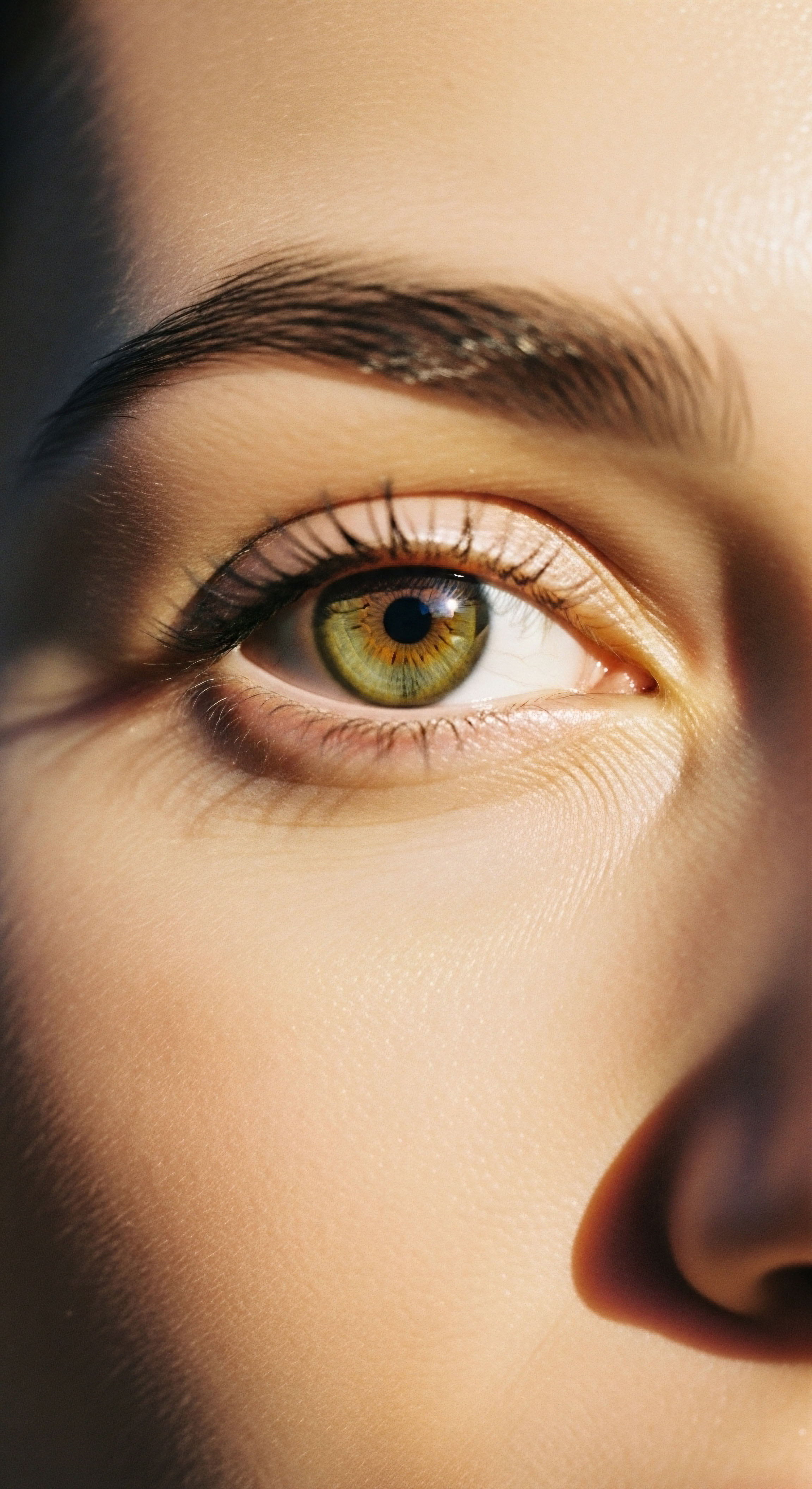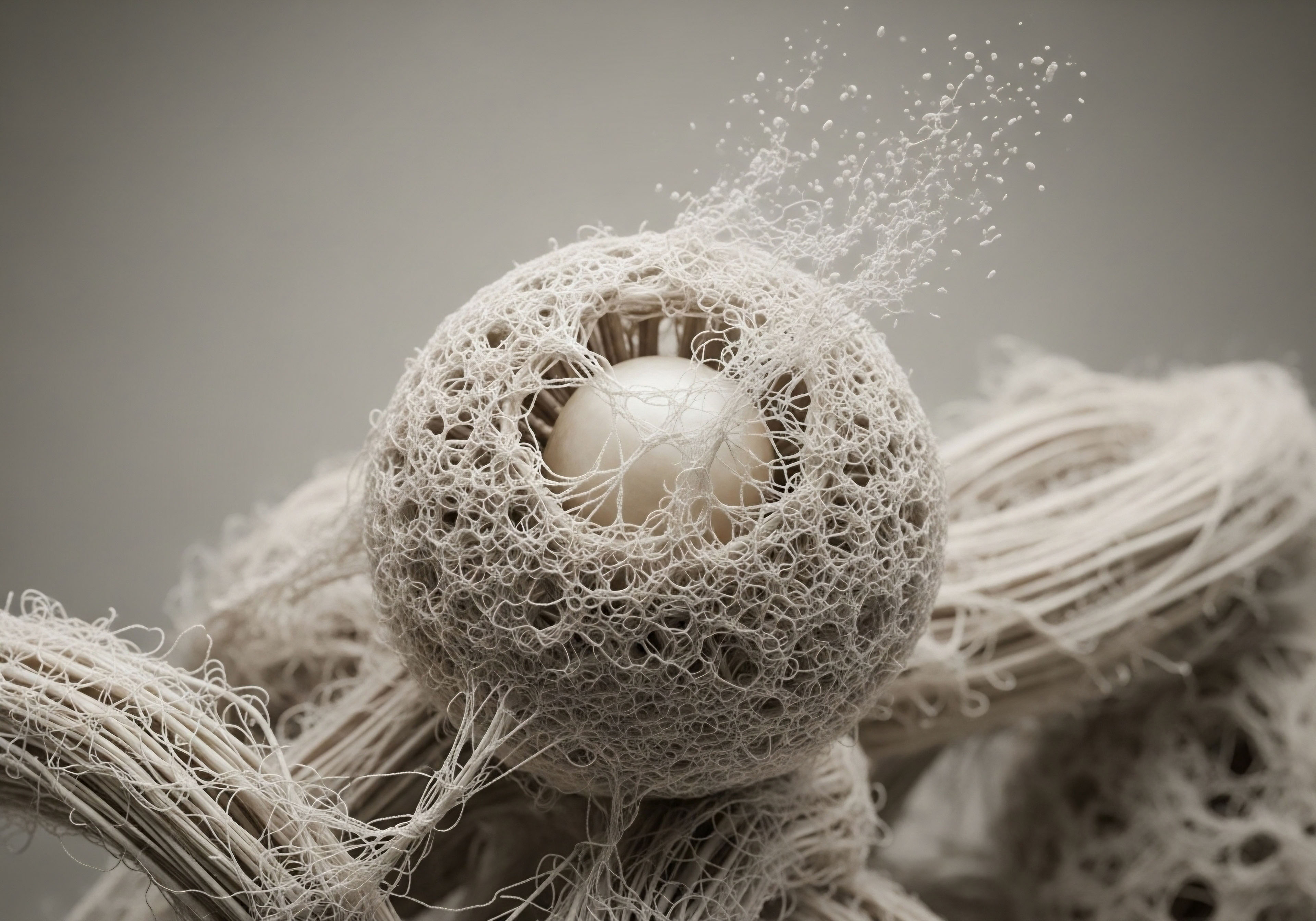

Fundamentals
You may have noticed changes in the texture and resilience of your skin, a reflection of deeper shifts occurring within your body’s intricate communication network. This experience is a valid and common starting point for a deeper investigation into your own biology. Your skin is a visible expression of your internal endocrine environment, a sensitive organ that responds directly to the ebb and flow of key signaling molecules. Understanding this connection is the first step toward reclaiming its vitality.
The question of whether lifestyle can amplify the benefits of hormonal optimization protocols for skin health Meaning ∞ Skin health denotes the optimal physiological state of the integumentary system, characterized by robust barrier function, structural integrity, and efficient cellular regeneration. is an astute one. It moves us toward a more complete, systems-based model of wellness.
Hormonal recalibration therapies function by reintroducing specific biochemical messengers that have diminished over time. These molecules instruct skin cells to behave more youthfully. Estrogen, for instance, is a primary driver of collagen and elastin synthesis, the proteins that form the skin’s structural foundation, providing firmness and recoil. Progesterone influences skin hydration and sebum production, contributing to a supple and well-moisturized barrier.
Even testosterone, in precise amounts, plays a role in maintaining skin thickness and structural integrity. When these levels are optimized through a targeted protocol, the skin receives the necessary signals to initiate repair and regeneration.
Optimizing hormone levels provides the foundational signals for skin cells to initiate comprehensive repair and structural regeneration.
This therapeutic signal, however, is just one part of the equation. The body requires the raw materials to carry out these instructions. This is where the profound influence of lifestyle factors comes into play.
A well-formulated diet and consistent physical activity Meaning ∞ Physical activity refers to any bodily movement generated by skeletal muscle contraction that results in energy expenditure beyond resting levels. provide the essential resources and enhance the physiological environment, allowing the skin to fully respond to the new hormonal directives. These elements work in concert, creating a powerful synergy that supports a visible and lasting improvement in skin health.


Intermediate
To appreciate how lifestyle choices enhance hormonal therapies, we must examine the specific biological pathways involved. Hormonal optimization protocols are designed to restore the biochemical signals that govern cellular function. Lifestyle factors, in turn, provide the fuel and the infrastructure necessary for these signals to be effectively received and acted upon. This partnership between clinical intervention and personal habits is what produces a truly robust and visible outcome for skin health.

The Synergistic Action of Nutrition
A therapeutic hormonal signal to produce more collagen is only effective if the necessary building blocks are available. A diet rich in specific nutrients directly supports the cellular machinery that HRT activates.
- Amino Acids ∞ Collagen is a protein composed of specific amino acids, primarily glycine, proline, and hydroxyproline. Consuming complete proteins from sources like lean meats, fish, and legumes provides the fundamental components required for fibroblasts to construct new collagen fibers.
- Vitamin C ∞ This vitamin is an indispensable cofactor in the enzymatic process that stabilizes the collagen molecule. Without adequate Vitamin C, the collagen produced is weak and degrades quickly. Citrus fruits, bell peppers, and leafy greens are excellent sources.
- Healthy Fats ∞ The outer membrane of every skin cell is a lipid bilayer. Dietary fats, particularly omega-3 fatty acids found in fish and flaxseed, are incorporated into these membranes, enhancing the skin’s barrier function, reducing water loss, and modulating inflammation.
- Antioxidants ∞ Compounds like Vitamin E, carotenoids, and polyphenols protect the skin’s newly formed collagen and existing structures from oxidative stress caused by environmental factors like UV radiation and pollution.

How Does Exercise Amplify the Effects
Physical activity acts as a powerful amplifier for the benefits of HRT on the skin. Its effects are systemic, improving the environment in which skin cells operate.
Regular physical activity enhances circulation and modulates inflammation, creating an optimal physiological environment for skin regeneration.
The primary mechanisms include enhanced circulation and improved insulin sensitivity. Increased blood flow delivers a greater supply of oxygen and the very nutrients you consume to the dermal layers, nourishing fibroblasts and other cells. This ensures that the instructions provided by HRT are met with an abundance of resources.
Simultaneously, exercise improves the body’s response to insulin, a hormone that, when dysregulated, can contribute to inflammation and skin degradation. By helping to maintain insulin sensitivity, exercise supports a less inflammatory internal environment, protecting the skin’s structural integrity.

Comparing Therapeutic Inputs
The following table illustrates how these three pillars work together to achieve superior results for skin health.
| Factor | Primary Role in Skin Health | Synergistic Action |
|---|---|---|
| Hormone Replacement Therapy | Provides the biochemical signals for cellular repair, collagen synthesis, and hydration. | Activates the cellular machinery for regeneration. |
| Nutrient-Dense Diet | Supplies the raw materials (amino acids, vitamins, fats) for building and protecting skin structures. | Provides the necessary components for the activated machinery to use. |
| Consistent Exercise | Improves delivery of nutrients and oxygen via enhanced circulation and reduces systemic inflammation. | Optimizes the environment for cellular work and protects the resulting structures. |
Academic
A deeper analysis of skin vitality reveals a complex interplay between endocrine signaling, metabolic function, and cellular biology. The benefits of combining hormonal replacement therapy with specific lifestyle interventions can be understood by examining the mechanisms at the dermal-epidermal junction and within the extracellular matrix Meaning ∞ The Extracellular Matrix, often abbreviated as ECM, represents the non-cellular component present within all tissues and organs, providing essential physical scaffolding for cellular constituents and initiating crucial biochemical and biomechanical signals. (ECM). The skin is not merely a passive recipient of hormones and nutrients; it is a dynamic, metabolically active organ where these inputs are integrated to determine its structural and functional fate.

Cellular Dialogue in the Dermis
The primary mechanism through which estrogen revitalizes the skin is by binding to estrogen receptors Meaning ∞ Estrogen Receptors are specialized protein molecules within cells, serving as primary binding sites for estrogen hormones. on dermal fibroblasts. This action stimulates the transcription of genes responsible for producing type I and type III collagen, elastin, and hyaluronic acid. Research has demonstrated that post-menopause, a decline in estrogen is directly correlated with a reduction in collagen content, leading to dermal thinning and increased wrinkling.
HRT effectively restores this signaling pathway, prompting fibroblasts to increase their synthesis of these critical ECM components. One study noted that HRT was associated with an increased abundance of total elastic fibers in post-menopausal women, highlighting a direct impact on the skin’s structural network.
This is where exercise provides a critical physiological advantage. Aerobic exercise induces angiogenesis and increases capillary density in the skin, a process that enhances perfusion. This heightened blood flow delivers a greater flux of oxygen and substrates—glucose, amino acids, and fatty acids—directly to the stimulated fibroblasts.
The result is an environment where the genetic instructions activated by HRT can be executed with maximum efficiency. The metabolic demands of a fibroblast actively synthesizing collagen are significant, and exercise ensures these demands are met.

The Protective Role of Nutrition against Matrix Degradation
The longevity of newly synthesized collagen is governed by the balance between its production and its degradation by enzymes called matrix metalloproteinases (MMPs). Chronic inflammation and oxidative stress, often exacerbated by poor diet and insulin resistance, can upregulate MMP activity, leading to accelerated aging. A diet rich in polyphenols and antioxidants directly counteracts this process.
These phytonutrients can help quench reactive oxygen species and modulate inflammatory pathways like NF-κB, thereby reducing the expression and activity of MMPs. This dietary strategy protects the very collagen and elastin that HRT and exercise work to build, preserving the skin’s structural integrity over the long term.
The synergy of HRT, diet, and exercise creates a powerful biological cascade that enhances both the synthesis and preservation of the skin’s vital protein matrix.

Impact on Epidermal Homeostasis
The influence extends to the epidermis. Studies have shown that menopause can alter epidermal lipid synthesis, specifically reducing ceramide levels, which are crucial for the skin’s barrier function. HRT has been shown to partially normalize these changes.
This effect can be further supported by a diet containing essential fatty acids, which serve as precursors for ceramide synthesis. The combination of systemic hormonal signaling and targeted nutritional input provides a comprehensive approach to restoring the skin’s protective barrier, improving hydration and reducing sensitivity.
| Biological Process | Effect of HRT | Enhancement by Diet | Enhancement by Exercise |
|---|---|---|---|
| Collagen Synthesis | Stimulates fibroblast gene expression for collagen production. | Provides essential amino acid and Vitamin C cofactors. | Increases oxygen and substrate delivery to fibroblasts. |
| ECM Preservation | Maintains a healthy dermal environment. | Provides antioxidants to inhibit MMP activity and reduce degradation. | Reduces systemic inflammation, lowering MMP upregulation. |
| Epidermal Barrier Function | Helps normalize ceramide and lipid production. | Supplies essential fatty acids as precursors for lipids. | Improves overall cellular health and turnover. |
References
- Salles-Costa, R. et al. “Combined effect of physical exercise and hormone replacement therapy on cardiovascular and metabolic health in postmenopausal women ∞ A systematic review and meta-analysis.” Frontiers in Endocrinology, vol. 13, 2022.
- Stevenson, S. et al. “Influence of menopause and hormone replacement therapy on epidermal ageing and skin biomechanical function.” Journal of the European Academy of Dermatology and Venereology, vol. 35, no. 1, 2021, pp. e69-e71.
- Lephart, Edwin D. “Skin aging and oxidative stress ∞ Equol’s anti-aging effects via gene expression.” Silicon, vol. 14, 2022, pp. 6795-6811.
- Rzepecki, Alexandra K. et al. “Estrogen-deficient skin ∞ The role of topical therapy.” International Journal of Women’s Dermatology, vol. 5, no. 2, 2019, pp. 85-90.
- Hall, G. and T. J. Phillips. “Estrogen and skin ∞ The effects of estrogen, menopause, and hormone replacement therapy on the skin.” Journal of the American Academy of Dermatology, vol. 53, no. 4, 2005, pp. 555-568.
Reflection

What Does Your Skin Tell You about Your System
The information presented here offers a map of the biological terrain connecting your hormones, your habits, and your health. It moves the conversation from isolated treatments to an integrated system of personal wellness. The true potential lies in understanding your own body’s unique responses. How does your energy shift with changes in your diet?
What does consistent physical activity feel like on a cellular level? Viewing your health protocols through this systemic lens is the foundation of a personalized and proactive path forward. The knowledge you have gained is a tool, empowering you to ask more precise questions and make choices that are deeply aligned with your own biological journey toward vitality.








